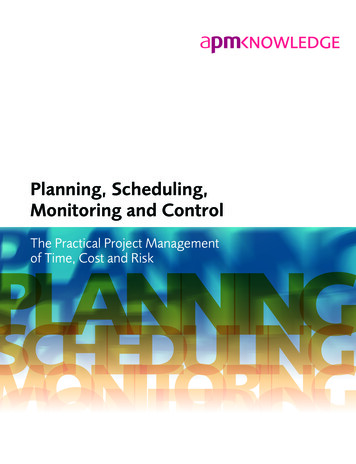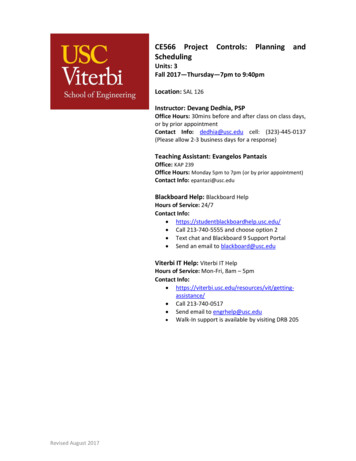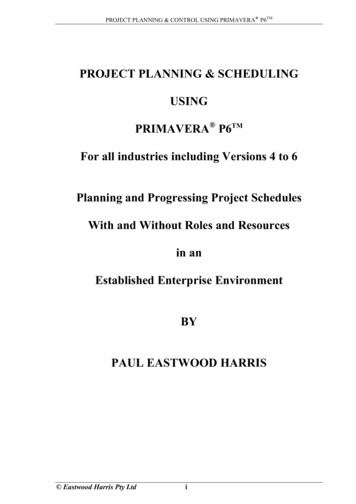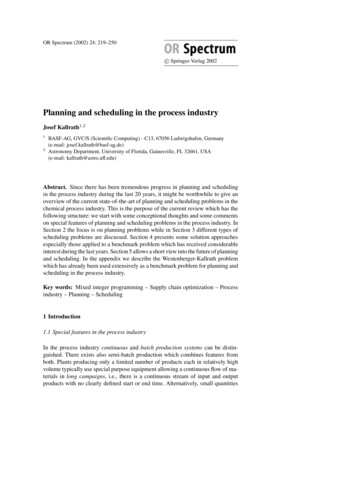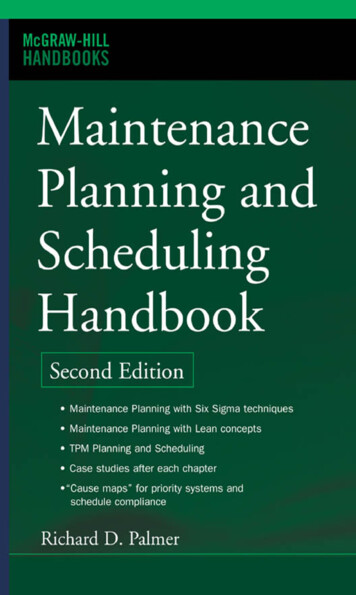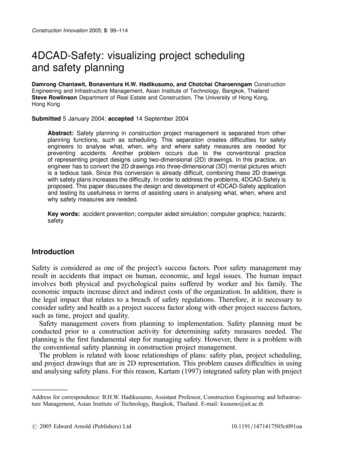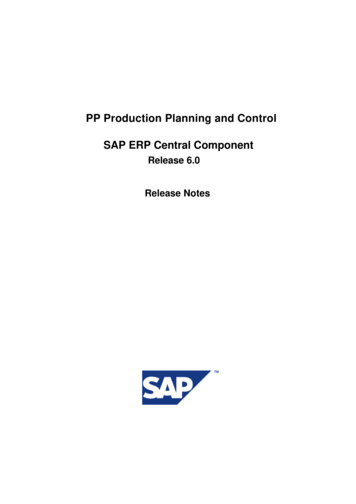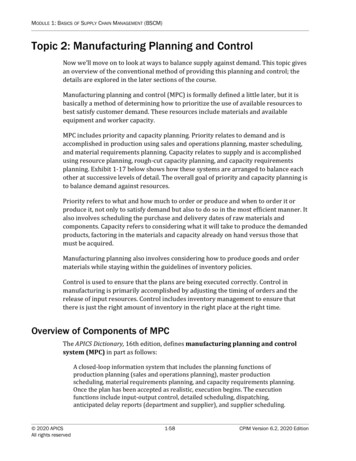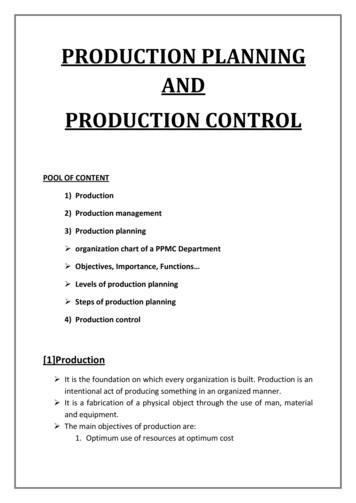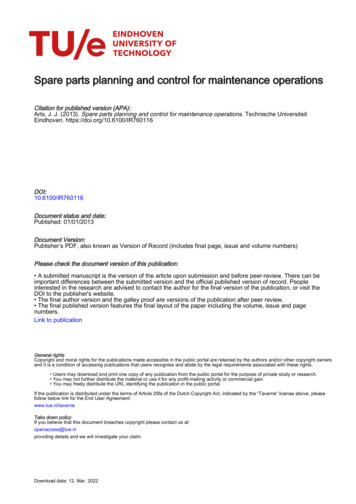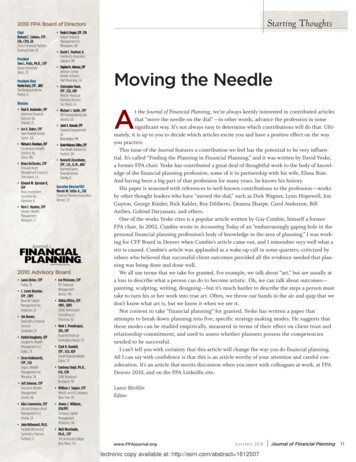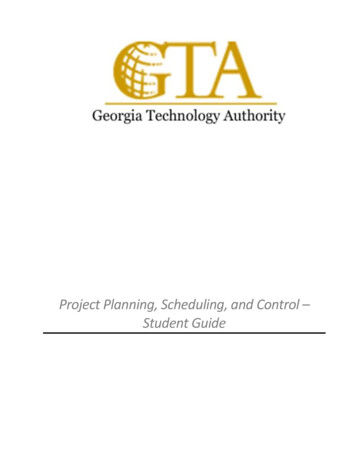
Transcription
Project Planning, Scheduling, and Control –Student Guide
Table of ContentsPreface for Students . 4Lesson 1: Definition of Project Work . 5Topic 1: Introduction to Project Time and Cost Management . 6Topic 2: Defining a Project Deliverable . 16Topic 3: Work Breakdown Structures. 19Topic 4: Exercise – Producing and Using a Project Deliverable . 25Lesson 1: Summary . 27Lesson 2: Sequencing Project Work .29Topic 1: Logic Diagrams . 30Topic 2: Activity Sequencing Templates (AON/AOA) . 40Topic 3: Activity Relationships for Precedence Diagramming Methods . 44Topic 4: Precedence Diagramming Method . 45Topic 5: Exercise – Producing an Activity Sequence. 53Topic 6: Guidelines to Estimation . 57Topic 7: Activity Resource Requirements . 59Lesson 2: Summary . 61Lesson 3: Schedule Development .65Topic 1: Developing a Project Schedule . 66Topic 2: Critical Path Method (CPM) . 72Topic 3: Leads and Lags . 74Topic 4: Schedule Compression . 76Topic 5: Resource Leveling . 85Lesson 3: Summary . 87Lesson 4: Time and Cost Estimation .90Topic 1: Parametric Modeling Estimation . 91Topic 2: Analogous Estimation . 92Topic 3: Bottom-up Estimation. 93Topic 4: Program Evaluation Review Technique . 95Topic 5: Exercise – Delivering a Project Estimate . 102Lesson 4: Summary . 104Lesson 5: The Project Budget . 107Topic 1: Allocating Contingency . 108Topic 2: Cost Budgeting and Baseline . 115Topic 3: Exercise – Presenting a Cost and Schedule Baseline . 126
Lesson 5: Summary .130Table of Contents (cont'd)Lesson 6: Controlling the Project Plan . 131Topic 1: Using Cost and Schedule Baselines to Control Projects .132Topic 2: Project Performance Measurement .137Topic 3: Forecasting Project Completion .140Lesson 6: Summary .146Appendix 1: Sample Answers. 149Lesson 1, Topic 1: Question – Introduction to Project Time and Cost Management . Error! Bookmark notdefined.Lesson 1, Topic 4: Exercise – Producing and Using a Project Deliverable .151Lesson 2, Topic 1: Exercise – Constructing a Logic Diagram .152Lesson 2, Topic 5: Exercise – Producing an Activity Sequence .154Lesson 3, Topic 4: Exercise – Compressing a Schedule.156Lesson 4, Topic 5: Exercise – Delivering a Project Estimate .159Lesson 5, Topic 3: Exercise – Presenting a Cost and Schedule Baseline.1623
Preface for StudentsAbout the Student GuideThis Student Guide is designed to supplement the presentation on Project Planning, Scheduling, and Control. Itincludes PowerPoint slidesThe PowerPoint presentation highlights the key points, concepts, illustrations and diagrams associated withthe course. This guide contains a grab of each slide in that presentation. student learning objectivesThe presentation is divided into a number of lessons. Each lesson is then further subdivided into a number oftopics. A topic is stand-alone piece of instruction that has a specific, demonstrable learning objective. Youshould begin each lesson by taking a moment to review the objectives. supplementary notesSupplementary notes appear with each slide, adding detail to what has been covered in the presentation. Itis recommended that you review these notes following each presentation.
Lesson 1: Definition of Project WorkTopic 1: Introduction to Project Time and Cost ManagementTopic 2: Defining a Project DeliverableTopic 3: Work Breakdown StructuresTopic 4: Producing and Using a Project DeliverableStudent learning objectivesAfter completing this lesson, you should be able to explain the basis of time and cost management and describe what elements are key to project planning describe how a work breakdown structure is used as an input to developing a project plan use a work breakdown structure and define work deliverables
Topic 1: Introduction to Project Time and Cost ManagementFigure based on the Project Management Institute, A Guide to the Project Management Body of Knowledge, (PMBOK Guide) – Fourth Edition, Project Management Institute, Inc., 2008.PMBOK is a registered mark of the Project Management Institute, Inc.A project team is likely to deal with some or all of the following in the course of a typical project: scope, cost, and schedule objectivescontract terms and conditionsresource assignmentsHowever, project managers continually face balancing the triple constraint – project scope, time, and cost – whenplanning any project. Project quality depends on the balance between these three constraints. High quality projectsdeliver required results within scope, on time, and within budget.Scope, time and cost plans are all part of the project management plan; the formal, approved document used to guideboth project execution and project control. (To view a sample Project Management Plan, see Tools & Templateshandout.)6Lesson 1: Definition of Project Work
Topic 1: Introduction to Project Time and Cost Management (cont’d)Figure based on the Project Management Institute, A Guide to the Project Management Body of Knowledge, (PMBOK Guide) – Fourth Edition, Project Management Institute, Inc., 2008.Sequence of Activities:Collect Requirements Define Scope Create WBS Verify Scope Control ScopeProject scope management is made up of a number of processes that define and control what work is included in theproject. These definitions are taken from the PMBOK Guide. Scope Management processes includes the following: Collect Requirements is the process of defining and documenting stakeholders’ needs to meet the projectobjectives. Define Scope is the process of developing a detailed description of the project and product. Create WBS is the process of subdividing project deliverables and project work into smaller, moremanageable components. Verify Scope is the process of formalizing acceptance of the completed project deliverables. Control Scope is the process of monitoring the status of the project and product scope and managing changesof the scope baseline.Lesson 1: Definition of Project Work7
Topic 1: Introduction to Project Time and Cost Management (cont’d)Project scope may refer to a product or a service. Work breakdown structures (WBS) are one of the most importanttools in project management and are issued in the project planning phase. The WBS presents a definition of theproject scope in the form of work packages.If the initial requirements of a project change as it progresses, this represents a change in the scope of the project.Similarly, if there are any changes to the project work regardless of how small or large, or whether they werespecifically requested or not, these also represent a change in project scope.Scope changes can make a project larger or smaller. They can also affect the timeline and cost of the project. Thesechanges in scope are commonly referred to as scope creep. In a nutshell, scope creep is the change or growth ofproject scope.Scope creep occurs most frequently during the later stages of a project, such as programming and testing, rather thanduring the earlier stages, such as design. This is a result of the project team gaining more knowledge of any earlyproblems and developing solutions to them.8Lesson 1: Definition of Project Work
Topic 1: Introduction to Project Time and Cost Management (cont’d)Collecting requirements is essential to the success of the project. According to the International Institute of BusinessAnalysis Business Analysis Body of Knowledge, v1.6, a requirement is “a condition or capability needed by astakeholder to solve a problem or achieve an objective”. Requirements are the building blocks for development of theWBS, schedules, test cases, and ultimate customer expectations. Requirements should be elicited, validated, specified,and verified.The project manager must understand that characteristics of a good requirement are: Complete: the requirement gives a detailed description of what is needed. Correct: the requirement should be appropriate to meet the goals of the project and accurately describes thestakeholder’s expectation. Unambiguous: the requirement should be written so that all readers arrive at a single consistentinterpretation. Verifiable: the requirement should be testable. Necessary: the requirement must be necessary to support at least one of the project goals. Feasible: the requirement must be possible to achieve for a reasonable cost. Prioritized: the requirement must be put in a priority ranking.Lesson 1: Definition of Project Work9
Topic 1: Introduction to Project Time and Cost Management (cont’d)Figure based on the Project Management Institute, A Guide to the Project Management Body of Knowledge, (PMBOK Guide) – Fourth Edition, Project Management Institute, Inc., 2008.Project Time Management:Define Activities Sequence Activities Estimate Activity Resources Estimate Activity Durations Develop Schedule Control SchedulePlanning is a project manager’s major responsibility. If project planning is performed correctly, then it is conceivablethat the project manager will work him/herself out of a job because the project can run itself. However in reality, thisis highly unlikely. Few projects are completed without some conflict or trade-off for the project manager to resolve.The stable elements of planning in any project are cost and time. Project time management includes those processesneeded to accomplish timely completion of a project. Project time management processes include the following:These definitions are taken from the PMBOK Guide. Project time management processes include the following:10 Define Activities – identifying the specific actions to be performed to produce the project deliverables Sequencing Activities – identifying and documenting relationships among the project activities Estimate Activity Resources – estimating the type and quantities of material, people, equipment, or suppliesrequired to perform each activity Estimate Activity Duration – approximating the number of work periods needed to complete individualactivities with estimated resources Develop Schedule – analyzing activity sequences, durations, resource requirements, and schedule constraintsto create the project schedule Control Schedule – monitoring the status of the project to update project progress and managing changes tothe schedule baselineLesson 1: Definition of Project Work
Topic 1: Introduction to Project Time and Cost Management (cont’d)On some projects, particularly smaller ones, the processes of activity sequencing, activity duration estimating, andschedule development are so tightly linked that they are viewed as a single process that can be performed by anindividual over a relatively short period of time.All well-managed projects, including large government projects, adhere to the time management processes of activitydefinition, activity sequencing, activity resource estimating, activity duration estimating, schedule development, andschedule control.Lesson 1: Definition of Project Work11
Topic 1: Introduction to Project Time and Cost Management (cont’d)This planning effort sets out the format and establishes criteria for the development and control of the projectschedule.The main task of the planning effort is to define the project scope. This is achieved using a work breakdown structure(WBS), which is a deliverable-oriented hierarchy of decomposed project components that organizes and defines thetotal scope of the project.The project time management planning function produces a developed project schedule and schedule managementplan that is contained in, or is a subsidiary plan of, the project management plan.This schedule management plan may be formal or informal, highly detailed or broadly framed, depending on theneeds of the project.12Lesson 1: Definition of Project Work
Topic 1: Introduction to Project Time and Cost Management (cont’d)Figure based on the Project Management Institute, A Guide to the Project Management Body of Knowledge, (PMBOK Guide) – Fourth Edition, Project Management Institute, Inc., 2008.Sequence of Activities:Cost Estimating Cost Budgeting Cost ControlProject cost management includes the processes involved in planning, controlling, and managing costs so that aproject can be completed within the approved budget. It can be broken down into the following three processes: cost estimating – developing an approximation of the costs and resources needed to complete projectactivities cost budgeting – aggregating the estimated costs of individual activities or work packages to establish a costbaseline for the total project cost control – influencing variations in the factors that create additional costs and controlling changes to theproject budgetProject cost management is mainly concerned with the cost of the resources, labor, and equipment required tocomplete project activities. It should also consider the effect of project decisions on the cost of using the product. Forexample, limiting the number of design reviews can reduce the cost of the project at the expense of an increase in thecustomer’s operating costs.Lesson 1: Definition of Project Work13
Topic 1: Introduction to Project Time and Cost Management (cont’d)In many application areas, the work of predicting and analyzing the prospective financial performance of the project’sproduct is done outside the project.In other application areas, such as capital facilities projects, project cost management also includes this work.When these predictions and analyses are included, project cost management encompasses additional processes andnumerous general management techniques, such as return on investment, discounted cash flow, earned value andinvestment payback analysis.Project cost management should consider the information needs of the project stakeholders. Different stakeholdersmeasure project costs in different ways and at different times. For example, the cost of an acquired item can bemeasured when the actual cost is incurred, or the actual cost can be recorded for project accounting purposes.Representative bodies in large governments generally assign funds to programs rather than individual projects. Eachproject must be funded by one or more of these programs.It is generally possible that a single project can contribute to the goals of more than one program. This is particularlycommon in transportation infrastructure projects. A road-widening project could be combined with pavementrehabilitation or seismic retrofitting, for example, even though each individual piece of work would be budgeted as aseparate program.A program is a group of related on-going projects that are managed in a coordinated way.Similar situations are common wherever new facilities are budgeted separately from rehabilitation. It generally makessense to have a new contractor perform both the new work and the rehabilitation at a particular location, as thisminimizes the overhead cost and the disruption to the occupants of the facility.14Lesson 1: Definition of Project Work
Topic 1: Introduction to Project Time and Cost Management (cont’d)The backbone of any good schedule or budget is a well-rounded work breakdown structure that includes allwork packages to fulfill the scope of the project requirements. A well-rounded work breakdown structurehas the following characteristics: the entire scope of work is includedthe agreed work packages can be associated with both a cost (i.e. resourcing, materials, etc.) and atime (i.e. a start and finish time can be interpreted)the work package can be identified at the lowest level and each preceding level is within the scopeof the projectEffective time and cost management is necessary to create a well-rounded WBS, which in turn is necessaryfor successful completion of the project. As each time and cost management process is completed, the WBSis updated and refined. The main processes of time management are activity definition, durationestimation, schedule development, and control. The main processes of cost management are estimation,budgeting, and control.Lesson 1: Definition of Project Work15
Topic 2: Defining a Project DeliverableFigure based on the Project Management Institute, A Guide to the Project Management Body of Knowledge, (PMBOK Guide) – Fourth Edition, Project Management Institute, Inc., 2008.Objective of the WBSThe work breakdown structure (WBS) is a deliverable-oriented hierarchy of decomposed project components thatorganizes and defines the total scope of the project.It is a representation of the detailed project scope statement that specifies the work to be carried out in the project.The elements of the WBS assist stakeholders in viewing the end product of the project. The work at the lowest-levelWBS component is estimated, scheduled, and tracked.A deliverable is any measurable, tangible, verifiable outcome, result, or item that must be produced to complete aproject or part of the project.Deliverables are linked to milestones in that a milestone is any significant event in the project, usually completion of amajor deliverable.A work package is a deliverable at the lowest level of the WBS, and can be used to help evaluate accomplishments.Work packages should be natural subdivisions of effort, planned according to the way the work will be done. However,when work packages are relatively short, little or no assessment of work-in-progress is required and the evaluation ofstatus is possible mainly on the basis of work package completions.The longer the work packages, the more difficult and subjective the work-in-process assessment becomes, unless thepackages are subdivided by objective indicators such as discrete milestones with pre-assigned budget values orcompletion percentages.To get a correct balance for defining a work package, the 80-hour rule of thumb can be used. It identifies workpackages where the duration of activities when possible be between 8 and 80 hours. Anything that exceeds this is nota single activity and should be further decomposed when possible.16Lesson 1: Definition of Project Work
Topic 2: Defining a Project Deliverable (cont’d)Defining Deliverables through DecompositionDecomposition involves subdividing the major project deliverables or sub deliverables into smaller, more manageablecomponents until the deliverables are defined in sufficient detail to support development of project activities(planning, executing, controlling, and closing).Decomposition involves the following major steps in identifying a deliverable: Identifies the major deliverables of the project, including project management and its associated activities.These deliverables should identify the entire scope of the project, nothing should be omitted.The major deliverables should always be defined in terms of how the project will actually be organized. Forexample, the phases of the project life cycle may be used as the first level of decomposition with the projectdeliverables repeated at the second level. Deciding whether adequate cost and duration estimates can be developed at this level of detail for eachdeliverable.Note, however, that the meaning of adequate may change over the course of the project. Decomposition of adeliverable that will be produced far in the future may not be possible.Identifying the Deliverable’s ComponentsThe components of the deliverable need to be described in terms of tangible, verifiable results in order to allowperformance measurement.Lesson 1: Definition of Project Work17
Topic 2: Defining a Project Deliverable (cont’d)As with the major components, each deliverable’s components need to be defined in terms of how the work of theproject will be organized and accomplished.Tangible, verifiable results can include services, as well as products. For example, status reporting could be describedas weekly status reports.In summary, project deliverables must be defined in sufficient detail to support development of project activities. Bydecomposing major project deliverables into components and naming them, it is possible to create a series ofactivities that can be estimated, scheduled, and tracked. These activities are known as work packages, and are thelowest level component of a WBS.18Lesson 1: Definition of Project Work
Topic 3: Work Breakdown StructuresWork Breakdown StructureA WBS is a deliverable-oriented grouping of project components that organizes and defines the total scope of theproject. Any work not in the WBS is outside the scope of the project.It is used to develop or confirm a common understanding of project scope. Each descending level within the WBSshows an increasingly detailed description of the project deliverables.A WBS is normally presented in the form of a chart. The WBS should not, however, be confused with the method ofpresentation. Simply drawing an unstructured activity list in chart form does not make it a WBS.Each item in the WBS is usually assigned a unique identifier, which is used to provide a structure for a hierarchicalsummation of costs and resources. The items at the lowest level of the WBS may be referred to as work packages,particularly in organizations that follow earned value management practices. These packages can be decomposedfurther, if necessary, into activities. The activities can then be sequenced and estimated to create the project schedule.Work component descriptions are often collected in a WBS dictionary.A WBS dictionary will typically include work package descriptions other planning information schedule dates cost budgets staff assignmentsLesson 1: Definition of Project Work19
Topic 3: Work Breakdown Structures (cont’d)The following is a fictional case study that illustrates how in major infrastructure projects distinct project phases andlife cycles must be completed before a project proceeds.Read the case study and then complete the exercise that follows it.The Georgia Rail ProjectIntroductionTraffic flow, congestion, and pollution are major issues for the state of Georgia. According to statistics gathered overthe past ten years, the number of licensed drivers has increased by 44%on average, 21% extra people travel into the major cities between 8:00 am and 1:00 am each working daythere has been a 47% increase in the use of automobiles during a working weekautomobile ownership was increased by 7% per yearover 77% of Georgia drivers now travel alone to work, whereas just over 14% avail of the carpool facility, and4% avail of public transportincidents of crashes are up 4%Project HistoryGeorgia’s transport needs have been under consideration for some time. In 1994, the state initiated an investigation,which led to the publication of a transport strategy report in 1997.The report found that the public did not consider the current public transportation system to be an adequatealternative to auto transport, resulting in a high reliance on the car.20Lesson 1: Definition of Project Work
Topic 3: Work Breakdown Structures (cont’d)Based on this, the report suggested that the state incorporate a series of measures into its transportation policy: review the current public transportation system and invest in new and alternative modes of publictransportation in urban commuter areasencourage and educate auto users so they see the benefits of alternative transportation with an emphasis onreducing “auto-reliance”After a period of discussion among various government bodies and other stakeholders, a committee – Transport 2000– was formed in 1999 to investigate the different alternatives. The committee evaluated alternatives based on expertopinion and historical information, as well as public opinion. The committee also identified the public as a keystakeholder in any transportation project and sought their opinion.For historical data and expert opinion, the committee looked to developments in Arizona, where a state-of-the-art, 1.13 billion project proposes to link three cities (Phoenix, Tempe, and Mesa) by rail. Funded by the Arizona stategovernment and the three cities, the Central Phoenix/East Valley Light Rail Transit system is scheduled for completionin August 2007. However, due to the success of the project, parts of the rail line will open to the commuter population1in December 2006 and April 2007 .The Central Phoenix/East Valley Light Rail Transit system has the capacity to transport around 5000 passengers in eachdirection every hour. A private company will operate the system under a five-year franchise.Project ProposalIn late 2000, the Transport 2000 committee proposed the establishment of a rail-based public transportation systembetween the major urban cities of the state. The objective was to provide a speedy, efficient, and cost-effectivecommuter system, allowing the state population to travel within and between urban districts.The committee detailed their plans to the state by breaking down the project specification into three sections: urban rail system: link each urban “business” area with a reliable light-rail systeminter-city connection: provide rail segments that will join each urban rail systemvendor management: identified as a key aspect for the success of the projectThe government accepted much of the committee’s evidence and the findings, but the major stumbling block was thebudget. The state did not accept that the committee could justify the level of investment required for the project withsufficient tangible benefits. It did not help that Phoenix’s system was not up and
Figure based on the Project Management Institute, A Guide to the Project Management Body of Knowledge, (PMBOK Guide) – Fourth Edition, Project Management Institute, Inc., 2008. PMBOK is a registered mark of the Project Management Institute, Inc. A project team is likely to deal with so
